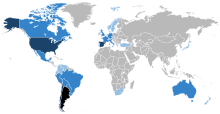
Back أرجنتينيون Arabic ارجنتينيين ARZ Аргенцінцы Byelorussian Аржентинци Bulgarian Argentinier German Αργεντίνοι Greek Argentinos Spanish Argentinar Basque آرژانتینیها Persian Argentins French
 | |
| Total population | |
|---|---|
| c. 46 million | |
| Regions with significant populations | |
| 256,071[2][3][a] | |
| 215,239[5] | |
| 85,202 (2022)[6] | |
| 79,744[7] | |
| 58,535[5] | |
| 48,312[8] | |
| 46,609[5] | |
| 23,500[9] | |
| 22,743[8] | |
| 17,999[8] | |
| 17,141[5] | |
| 14,190[8] | |
| 10,214[8] | |
| 10,200[8] | |
| 9,740[8] | |
| 9,391[5] | |
| 9,091[10] | |
| 3,842[11] | |
| 3,762 | |
| 3,000[8] | |
| 2,189[8] | |
| 1,824[12] | |
| 1,046[8] | |
| Languages | |
| Primarily Spanish (Rioplatense Spanish) | |
| Religion | |
| Predominantly Christian (mainly Catholicism)[13][14] | |
Argentines are the people identified with the country of Argentina. This connection may be residential, legal, historical or cultural. For most Argentines, several (or all) of these connections exist and are collectively the source of their being Argentine. In the past the National Gentilic for Citizens of Argentina was mistakenly translated as Argentinians, a term that is no longer considered accurate.[15][16]
Argentina is a multiethnic society, home to people of various ethnic, religious, and national origins, with the majority of the population made up of Old World immigrants and their descendants.[17][18][19] As a result, Argentines do not equate their nationality with ethnicity, but with citizenship and allegiance to Argentina. Aside from the indigenous population, nearly all Argentines or their ancestors immigrated within the past five centuries. Among countries in the world that have received the most immigrants in modern history, Argentina, with 6.6 million, ranks second to the United States (27 million), and ahead of other immigrant destinations such as Canada, Brazil and Australia.[20][21]
- ^ "United Nations population prospects" Archived 31 August 2015 at the Wayback Machine(PDF) 2015 revision
- ^ "TablaPx". www.ine.es. Archived from the original on 25 May 2017. Retrieved 22 May 2017.
- ^ a b "Población (españoles/extranjeros) por País de Nacimiento, sexo y año". Instituto Nacional de Estadística. 2018. Archived from the original on 21 April 2017. Retrieved 26 January 2019.
- ^ "Población extranjera por Nacionalidad, comunidades, Sexo y Año". Instituto Nacional de Estadística. 2018. Archived from the original on 21 February 2022. Retrieved 26 January 2019.
- ^ a b c d e "Emigrantes de Argentina según país de destino (2017)". 2017. Archived from the original on 14 February 2022. Retrieved 21 June 2019.
- ^ Perfil Migratorio de Argentina. Buenos Aires: Organización Internacional para las Migraciones. 2022. p. 184. ISBN 978-92-9068-657-6.
- ^ Number of Argentine citizens living in Brazil (2022)
- ^ a b c d e f g h i j Perfil migratorio de Argentina 2012 [Migratory profile of Argentina 2012] (PDF). Buenos Aires: International Organization for Migration. 2012. p. 184. ISBN 978-92-9068-657-6. Archived (PDF) from the original on 4 July 2014. Retrieved 2 March 2013.
- ^ "Canada Census Profile 2021". Census Profile, 2021 Census. Statistics Canada Statistique Canada. 7 May 2021. Archived from the original on 3 January 2023. Retrieved 3 January 2023.
- ^ "Argentini in Italia - statistiche e distribuzione per regione". Tuttitalia.it (in Italian). Archived from the original on 7 June 2022. Retrieved 7 June 2022.
- ^ "Folkmängden efter födelseland, ålder och kön. År 2000 - 2020". Archived from the original on 11 October 2021. Retrieved 14 November 2021.
- ^ "Argentinian ethnic group". Stats NZ. Archived from the original on 10 June 2022. Retrieved 10 June 2022.
- ^ Religion in Latin America: Widespread Change in a Historically Catholic Region (PDF). Pew Research Center. 13 November 2014. pp. 14, 162, 164. Archived from the original (PDF) on 20 September 2016. Retrieved 28 July 2015.
- ^ Adams, Fiona (2011). CultureShock! Argentina: A Survival Guide to Customs and Etiquette. Marshall Cavendish International Asia Pte Ltd. p. 97. ISBN 9789814346771. Archived from the original on 27 September 2023. Retrieved 15 October 2020.
Argentina despite this being a Catholic country.
- ^ "Argentina: The World Factbook". 16 September 2023. Archived from the original on 17 April 2021. Retrieved 16 September 2023.
- ^ "Nationality: The World Factbook". 16 September 2023. Archived from the original on 23 September 2023. Retrieved 16 September 2023.
- ^ "Encuesta Complementaria de Pueblos Indígenas 2004–2005" (in Spanish). National Institute of Statistics and Census of Argentina. Archived from the original on 11 June 2008.
- ^ Cruz-Coke, R.; Moreno, R.S. (1994). "Genetic epidemiology of single gene defects in Chile". Journal of Medical Genetics. 31 (9): 702–06. doi:10.1136/jmg.31.9.702. PMC 1050080. PMID 7815439.
- ^ "About Argentina". Government of Argentina. Archived from the original on 19 September 2009.
- ^ "Capítulo VII. Inmigrantes" (PDF). 10 June 2007. Archived from the original (PDF) on 10 June 2007.
- ^ "European Immigration Into Latin America, 1870-1930" (PDF). 14 August 2011. Archived from the original (PDF) on 14 August 2011.
Cite error: There are <ref group=lower-alpha> tags or {{efn}} templates on this page, but the references will not show without a {{reflist|group=lower-alpha}} template or {{notelist}} template (see the help page).
© MMXXIII Rich X Search. We shall prevail. All rights reserved. Rich X Search